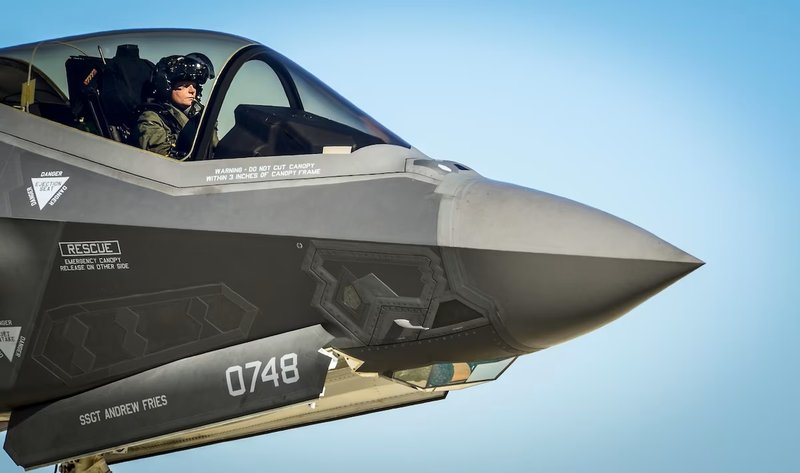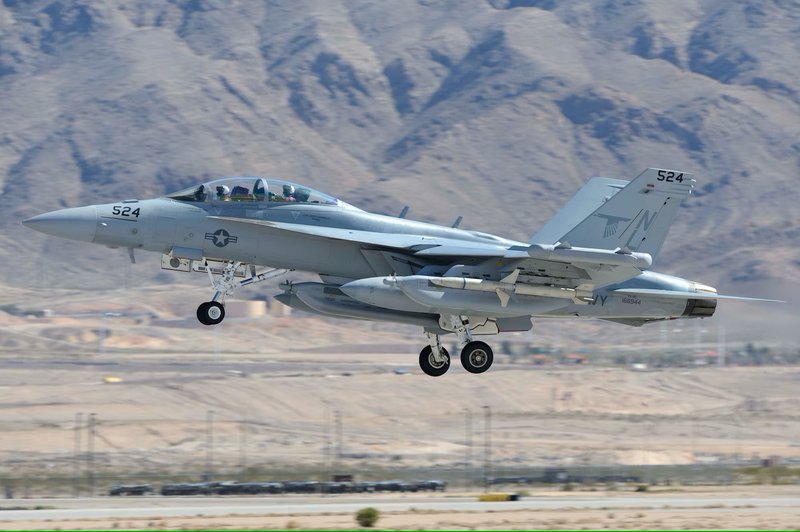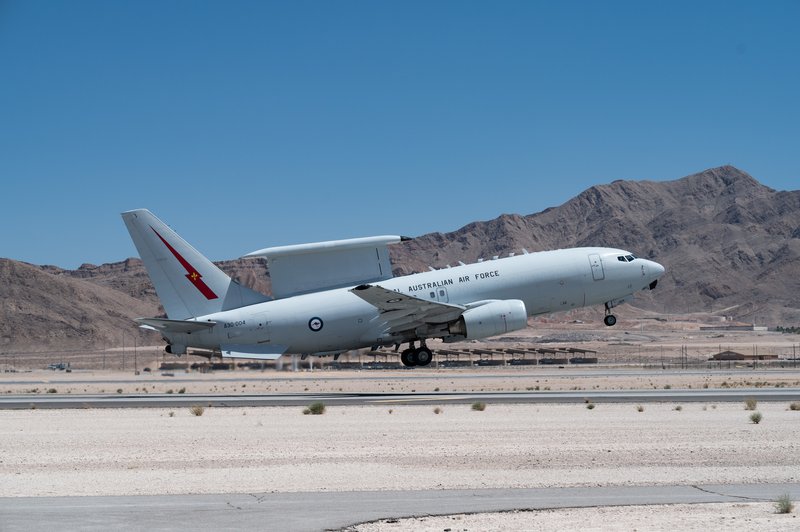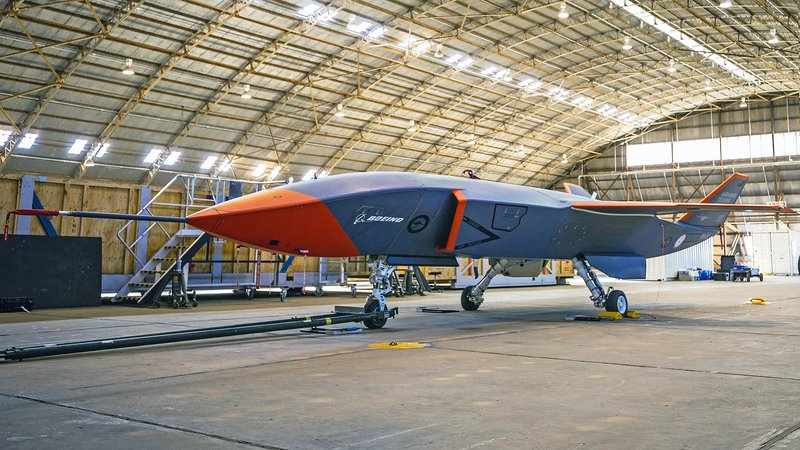Airborne early warning and electronic warfare: can modern fighters do it for themselves?
It is now a cliché to observe that current-generation combat aircraft are designed for multiple roles, either through structural and design options or onboard systems that can change focus and capabilities mid-mission.
This has led to a slight dichotomy in the concept of military aircraft operations, in that each platform is extremely powerful and adaptable and hence can successfully perform roles independently of others. Continues below...
Newsletter Sponsors:

Above: Modern fighter jets’ radar and jamming capability equals that of specialist AEW and EW platforms of 30 years ago, but is not guaranteed to prevail against a peer adversary. (Photo: USAF)
Yet the complexities of contemporary operations mean that these capabilities are usually best exploited with mixed formations.

The area where this is most obvious is the electromagnetic sphere. Almost all new combat aircraft possess advanced radars, usually an AESA design using gallium nitride as the transmit/receive material. This is a massive boost over the previous generation in terms of capability offered.
Many also have complex passive systems, usually combined with the active radar, to listen out for potential threats. Missile approach warning systems – often connected to dedicated forward-looking infrared targeting – sweep the IR wavelength to ensure the aircraft detects ‘silent’ foes not transmitting on any frequency.
On paper, this would seemingly make a modern fighter virtually invulnerable and that is exactly what most platform and system designers like to claim. The range of active and passive system on board are the equivalent of a squadron of specialised types of 1990s vintage.
So has the place for dedicated airborne early warning (AEW), electronic warfare (EW) and air defence suppression (SEAD) died out? Fears over the vulnerability of these platforms and the hamstringing that would result from their loss are a indeed common theme of defence conferences.
But can a fighter simply now take care of itself without help? The honest operational answer is a guarded ‘possibly’, although such considerations are often secondary to the realities of defence budgets.

One of the key philosophical problems with supposing new fighters can ‘do’ AEW, EW or SEAD is that the enemy also gets a vote. Recent events have shown opposing forces can be over- as well as underestimated, but with the concept of multi-functional aircraft well understood it can be assumed that a hostile state will be developing its counters to this construct, and these may come as a nasty surprise.
Having a smaller number of more capable aircraft brings benefits, but this kind of fleet tends to reduce the variety of forms that an operation can take, something not lost on an adversary. The individual aircraft may have become more capable, but the new fleet can only be in so many places at one time.
A subsidiary and often missed element is the difficulty of getting a fighter-sized aircraft to concurrently operate all its systems. Modern radars and jammers are power-hungry and can exceed the ability of onboard generators, as well as causing cooling problems.
With an aircraft’s physical form largely unchanged over decades, there is a limit to how this aspect can be managed as onboard systems develop, and the issue worsens. The torrid F-35 Block 4 saga is in some ways an issue of power and cooling as much as software. To paraphrase a popular film about fighters, the systems are writing cheques the generator cannot cash.
This can be moderated by the use of powerful data links such as the ubiquitous Link-16. Theoretically, different aircraft may focus on a particular task and share output with the whole force. Unfortunately, this also places some limits on the form of an operation, as successfully combining different roles and sharing the output requires distances and other elements to be observed.

The opposition will be doing all in its power to negate this, either through its own EW efforts – including jamming data links – or orienting threats so that most of the formation must rely on multiple onboard systems rather than be free for an individual task focus.
Despite the assurances of aircraft manufacturers, this conundrum has not been lost on operators. Fighters can offer mutual support and do not always need specialist assistance, but there are limits.
Ground-based assistance is available, but basic physics are against it. While the conflict in Ukraine is of a particular nature and hence not a perfect guide to future warfare, air operations have proven difficult for both sides owing to poor AEW and EW support and rapidly changing threat pictures.
The question, then, is can the circle be squared and the self-escorting fighter made to work despite complex environments and small fleet numbers?

Above: The EA-18G adds powerful jammers to the Super Hornet airframe but these must be carried externally. (Photo: USN)
There are several possible solutions. The first is continued insertion of technology into the airframe to improve capability and solve the power and cooling question. This is the hope of the F-35 Block 4 programme, although the jury remains out as to whether it will fix or exacerbate the basic problem of a small airframe with powerful onboard systems.
The second option is to add capability onto rather than inside an airframe. The most obvious examples of this are the huge jammers carried by the USN’s EA-18G fleet. These take the pressure off the strike aircraft and while the Growlers are a specialist model, they also carry weapons using essentially the same airframe as their conventional stablemates.

Trillium Engineering specializes in the design and production of gimballed imaging systems for manned and unmanned aircraft. See Details
This approach is being followed by Saab, which has put considerable effort into its AREXIS EW escort pod. This can be carried by the Gripen and intended also for export. External and independent of the onboard core, it adds its own generator and cooling so can operate without strain on existing power systems.
Unlike the EA-18’s hardware, it can be carried by all Gripen models with no rewiring needed. But both Swedish and US solutions bring the obvious problems of added weight and drag as well as a rise in RCS. As ever, various opportunity costs and trade-offs exist and individual operators calculate these differently.
But the most drastic path is to accept that a fighter with the capabilities of an AEW and EW specialist platform cannot exist in practical form and return to mixed fleets. The market for new Boeing E-7, Saab GlobalEye and IAI CAEW aircraft seems strong despite their customers operating very modern fighter fleets.

Above: The fact that forces such as the USAF plan to order a large fleet of E-7s suggests that the era of the bespoke AEW aircraft are far from over. (Photo: US DoD)
Only the US has a large fleet of wider EW aircraft such as the new Compass Call and these are admittedly not intended to participate in fighter operations, but add their capabilities to the mix and degrade wider enemy ability to react. Other operators have some of this capability, but not to the same exquisite degree.
Observant readers will recall this is a solution that was questioned at the top of the article. These aircraft, together with aerial tankers, are termed ‘high-value assets’ for just these reasons of small numbers and great vulnerability. The increased range of modern weapons has increased both these platforms’ risk level and the need to escort them.
Can UAS provide the answer? While it should be acknowledged that no one has yet managed to field a true ‘loyal wingman’, the AEW/EW support role would be a good fit for this platform whenever it eventually emerges. The closest example is the highly useful Boeing MQ-25, operated from US aircraft carriers.
Although it is at present ‘demoted’ to an aerial refuelling role, it has a clear future accompanying fighters where the E-2D Hawkeye cannot be risked but wider, survivable coverage is required in the AEW and EW roles.
A carrier strike group carries only five to eight Growlers, so these are in great demand for high-risk missions where their added threat visibility and countermeasures are deemed vital. Boeing Australia is offering the MQ-28 Ghost Bat for a similar dedicated support role, using its own radar and EW systems to bolster combat formations.

Above: Future fighter fleets may be accompanied by larger UAS such as the MQ-28 in the AEW or EW roles rather than crewed platforms. (Photo: Boeing Australia)
That it can be sacrificed without loss of life is another benefit, although as has been stated before the attritable versus capable balance of these UAS designs is quite complicated and may not be achievable; it is more likely to prove an either/or.
Removing an internal weapons bay, reducing complication, increasing room for power, fuel and cooling would allow greater focus on more specialist missions but clearly this is a design and customer decision.
Like the self-escorting bomber of the 1930s, the concept of a single-type fighter fleet operating independently of support has strong adherents. Under many circumstances it likely can work. But it will lack the onboard power to match the capability provided by dedicated aircraft or the numbers provided by a larger fleet.
Despite assurances of combat aircraft OEMs, concurrent development and procurement of specialised systems, pods and aircraft suggests that customers are hedging their bets. Current-generation fighters will not match a contemporary AEW or EW-focussed platform, but the later will not possess the flexibility or survivability of the former. Hence this, possibly more than weapons delivery, is an area where larger UAS may prove key.
The ability for a standard fighter type to offer an equivalent AEW and self-escorting joint EW capability is a goal that is probably unobtainable. For most operations an 80% solution is likely to be acceptable, but the need to plan for the worst and the unknown intent of the enemy mean likely continuation of small, specialist fleets alongside the fighters, concurrent with developing UAS assistance. By the mid-2030s this is likely to have become the common solution among leading air forces.
Don't want to miss out on future Decisive Edge content? Make sure you are signed up to our email newsletters.














